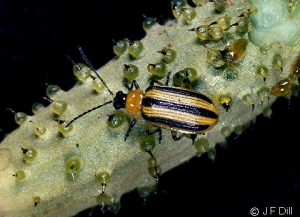Striped Cucumber Beetles
Pest Management Fact Sheet #5038
 James F. Dill, Pest Management Specialist
James F. Dill, Pest Management Specialist
Clay A. Kirby, Insect Diagnostician
For information about UMaine Extension programs and resources, visit extension.umaine.edu.
Find more of our publications and books at extension.umaine.edu/publications/.
Description & Biology
The striped cucumber beetle is one of the most damaging pests on cucurbits such as squash, cucumber, melon and pumpkin. The larvae can cause severe damage to roots. A single beetle can cause severe damage to an emerging plant by feeding on the lower surface of leaves. Adults are known to feed inside flowers, preventing pollination and fruit set. These beetles also spread bacterial wilt, cucumber mosaic virus, and squash mosaic virus.
The striped cucumber beetle is about 1/5 inch long, and has a black head and yellow-green wing coverings adorned with three black longitudinal stripes. The orange-yellow eggs are laid near the base of the host plants. The slender white larva grows to about 1/3 inch long and is dark on each end. There is one generation per year.
Only unmated adults overwinter. They overwinter under leaves, rotten logs or almost any other debris found on the ground. They emerge from dormancy in the spring when soil temperatures reach 55°F. The newly-awakened adult beetles initially feed on pollen, petals and leaves of willow, apple, hawthorn and more specifically, on their alternate hosts of goldenrod, aster, etc. However, as soon as cucurbits–their preferred hosts–come up or are transplanted, the beetles will fly to these plants to feed and mate.
Only a few days after mating, the female striped cucumber beetle lays her eggs in the soil. The eggs hatch in about 10 days. The larvae work their way to the plant roots where they feed for the next 2 to 6 weeks, sometimes causing severe damage. The mature larvae pupate in the soil. 7 to 10 days later, the adult beetles emerge.
Management
Due to the fact that overwintering cucumber beetles are around by the time cucurbits are up or transplanted, it is important to check at least daily to control this pest. Hand-picking is most effective if done early in the morning. These beetles are easy to kill, but because new ones arrive at the plants over an extended period, it sometimes feels as though controls are not working. Barriers of row covers such as spunbonded polyester remay, cheesecloth, etc. (which may have to be suspended over crops with wire hoops to prevent foliar abrasion during windy locations) can protect your plants; remove by midsummer to enable adequate pollination (by pollinating insects).
Removal of goldenrod, aster, etc., from the vicinity of cucurbits helps reduce the number of beetles. Removing plant debris or keeping it to a minimum is also advisable.
Insecticides labeled for vegetables containing pyrethrins or carbaryl (Sevin®) should control the beetles.
When Using Pesticides
ALWAYS FOLLOW LABEL DIRECTIONS!
Pest Management Unit
Cooperative Extension Diagnostic and Research Laboratory
17 Godfrey Drive, Orono, ME 04473
1.800.287.0279 (in Maine)
Information in this publication is provided purely for educational purposes. No responsibility is assumed for any problems associated with the use of products or services mentioned. No endorsement of products or companies is intended, nor is criticism of unnamed products or companies implied.
© 2016, 2018 | Reviewed: 2020, 2023
Call 800.287.0274 (in Maine), or 207.581.3188, for information on publications and program offerings from University of Maine Cooperative Extension, or visit extension.umaine.edu.
In complying with the letter and spirit of applicable laws and pursuing its own goals of diversity, the University of Maine System does not discriminate on the grounds of race, color, religion, sex, sexual orientation, transgender status, gender, gender identity or expression, ethnicity, national origin, citizenship status, familial status, ancestry, age, disability physical or mental, genetic information, or veterans or military status in employment, education, and all other programs and activities. The University provides reasonable accommodations to qualified individuals with disabilities upon request. The following person has been designated to handle inquiries regarding non-discrimination policies: Director of Equal Opportunity, 101 Boudreau Hall, University of Maine, Orono, ME 04469-5754, 207.581.1226, TTY 711 (Maine Relay System).

